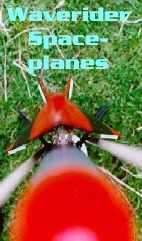
Future Waverider Development and Research
Hypersonic sail Waveriders.
As the outer portions of a waverider underside are concave, flexible skins of woven metal, such as stainless steel or titanium 'cloth' or conductive composites, will billow out into the correct concave shape due to the undersurface pressure just like a hanglider canopy, provided poles or booms secure the leading edges. While not so aerodynamically clean, these sails give phenomenally low wingloadings if fitted under any re-entering body, allowing re-entry at very high altitudes indeed, leading to extremely low heating rates, especially as their leeward surfaces are huge radiators.
Investigation into hypersonic sail Waveriders is an area offering fruitful results in terms of re-entry heating, simplicity, and not forgetting the possibility of folding the sails away compactly during launch.
Laser Propulsion Systems for Waveriders
Airspike Drag reduction techniques for Waveriders
The use of an laser or microwave induced airspike ahead of the waverider offers tremendous reductions in the drag of the vehicle. A plasma is generated ahead of the vehicle by means of a focussed laser or microwave beam. Pulsing the output produces a series of detonation waves. The shock wave thus generated can then control the airflow around the vehicle.
Current techniques developed in the U.S. by Professor Leik Myrabo at Rensselaer Polytechnic Institute (Microwaves) and Yuri Raizer at the Institute for Problems in Mechanics, in Moscow, Russia (Lasers) are concerned with focussing a beam on the vehicle, which then harnesses the beam energy to produce the airspike and propulsion.





